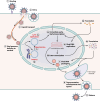HIV-associated cancers and lymphoproliferative disorders caused by Kaposi sarcoma herpesvirus and Epstein-Barr virus
- PMID: 38899877
- PMCID: PMC11391709
- DOI: 10.1128/cmr.00022-23
HIV-associated cancers and lymphoproliferative disorders caused by Kaposi sarcoma herpesvirus and Epstein-Barr virus
Abstract
SUMMARYWithin weeks of the first report of acquired immunodeficiency syndrome (AIDS) in 1981, it was observed that these patients often had Kaposi sarcoma (KS), a hitherto rarely seen skin tumor in the USA. It soon became apparent that AIDS was also associated with an increased incidence of high-grade lymphomas caused by Epstein-Barr virus (EBV). The association of AIDS with KS remained a mystery for more than a decade until Kaposi sarcoma-associated herpesvirus (KSHV) was discovered and found to be the cause of KS. KSHV was subsequently found to cause several other diseases associated with AIDS and human immunodeficiency virus (HIV) infection. People living with HIV/AIDS continue to have an increased incidence of certain cancers, and many of these cancers are caused by EBV and/or KSHV. In this review, we discuss the epidemiology, virology, pathogenesis, clinical manifestations, and treatment of cancers caused by EBV and KSHV in persons living with HIV.
Keywords: AIDS; Castleman; EBV; HIV; KSHV; Kaposi; gammaherpesvirus; lymphoma.
Conflict of interest statement
K.A.L., R.Y., and R.R. report receiving research support from Celgene (now Bristol Myers Squibb), PDS Biotech, Dren Bio, CTI Biopharma/SOBI, and Janssen Pharmaceuticals through Cooperative Research and Development Agreements (CRADAs) with the NCI and receiving drugs for clinical trials from Merck, PDS, EMD-Serono, Eli Lilly, CTI/SOBI through CRADAs with the NCI. K.A.L. and R.Y. report receiving pre-clinical materials from Lentigen through a CRADA. R.Y. is a co-inventor on U.S. patent 10,001,483 entitled "Methods for the treatment of Kaposi's sarcoma or KSHV-induced lymphoma using immunomodulatory compounds and uses of biomarkers." An immediate family member of R.Y. is a co-inventor on patents or patent applications related to internalization of target receptors, epigenetic analysis, and ephrin tyrosine kinase inhibitors. All rights, title, and interest to these patents have been assigned to the U.S. Department of Health and Human Services; the government conveys a portion of the royalties it receives to its employee inventors under the Federal Technology Transfer Act of 1986 (P.L. 99-502).
Figures









References
Publication types
MeSH terms
Grants and funding
LinkOut - more resources
Full Text Sources
Medical

